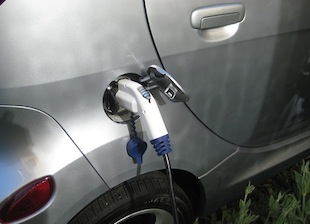 Panasonic Enterprise Solutions Company announced this week it’s partnering with Powertree Services Inc. to build out 68 electric-vehicle charging stations combined with solar systems and battery storage at multi-unit residences in San Francisco.
Panasonic Enterprise Solutions Company announced this week it’s partnering with Powertree Services Inc. to build out 68 electric-vehicle charging stations combined with solar systems and battery storage at multi-unit residences in San Francisco.
The project provides several benefits to building owners. They can offer residents convenient EV charging powered by on-site PV panels. And the solar system, combined with batteries, can provide backup power in the event of a grid outage. The batteries also enable a more streamlined EV charger installation process by either deferring or eliminating the need for expensive electrical system upgrades at the housing facility.
“Owners of multi-tenant apartment and mixed-use buildings face a rising demand from tenants, drivers and new regulations that combine to require them to install, manage, upgrade electric charging facilities and support electric vehicles,” said Stacey Reineccius, founder and CEO of Powertree, a private owner-operator of integrated solar PV generation, EV charging and grid-interactive energy storage.
The utility, Pacific Gas and Electric, could also benefit. The combination of solar and storage will help to smooth the spike in demand from high-power EV charging and provide ancillary services to support the grid.
“That’s why we feel our solution is a bit unique. It’s not only handling EV charging requirements without the burden of installing chargers, but also offering those utility grid services,” said Jon Ethington, project manager for Panasonic.
Bringing together three solutions — vehicle charging with solar and battery backup — “has multiple benefits for every stakeholder, be it EV customers, the building owner, or the utility,” he added.
Earlier this month, NRG eVgo partnered with Green Charge Networks to deploy distributed energy storage at eVgo’s Freedom Stations. The integrated systems allow end users to reduce consumption and avoid high demand charges during peak times, but are targeted at commercial buildings and won’t necessarily include solar generation.
The 68 hybrid stations by Panasonic-Powertree are already under construction and scheduled for completion by April 2015.
Partnering with entrepreneurs like Reineccius at Powertree has proven “very effective” at expanding the firm’s clean energy offerings, said Ethington. Panasonic’s partners can benefit from things like better buying power for new components, long-term financing and greater reach. Panasonic, meanwhile, moves closer to its goal of becoming the leader in green innovation in the electronics industry by 2018.
The company has already made great strides to that end. Panasonic has partnered with Tesla Motors to build the $5 billion Giga battery factory in Nevada. It tops the list of smart grid patent holders. And, through joint project development with financier Coronal Group, Panasonic has grown its aggregate installed capacity of solar from 2 megawatts to more than 100 megawatts in just a couple of years’ time.
“Our focus is really on helping customers, end users, developers, installation partners and the like, from Canada down through South America, to really be successful and enable their product vision,” said Ethington. “We bring our full end-to-end project lifecycle development, engineering, project delivery and construction [knowledge], all the way through twenty-years-plus operation and maintenance with financing and support.”
That’s the message Panasonic is driving home at this year’s Solar Power International conference.
Source: Greentech Media. Reproduced with permission.








